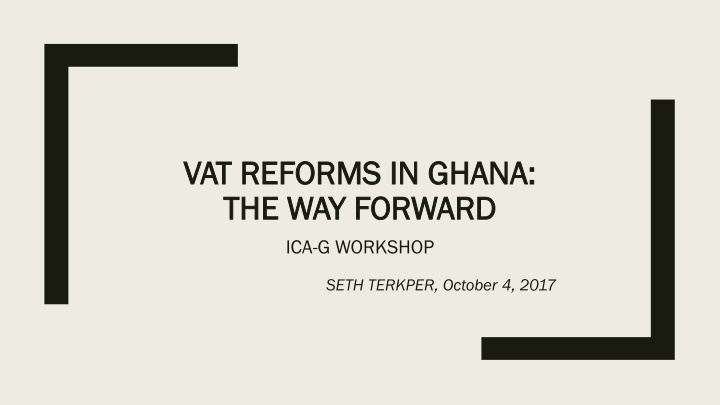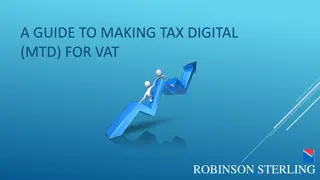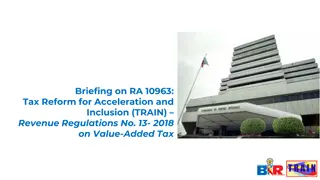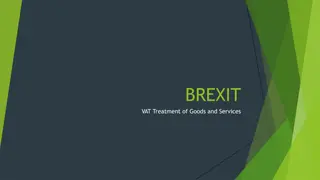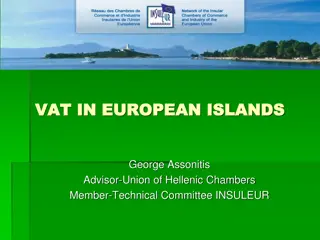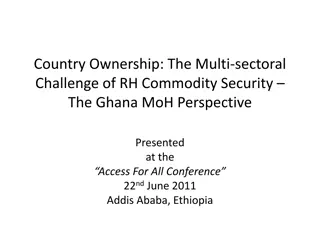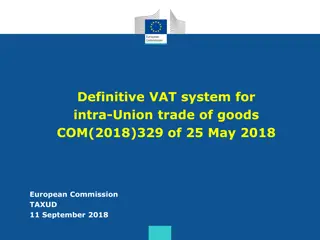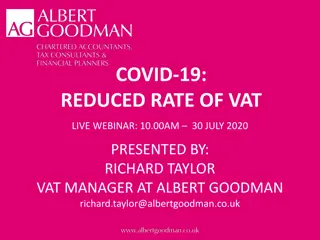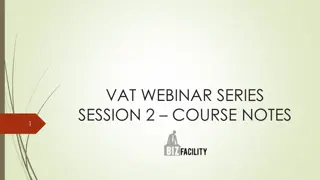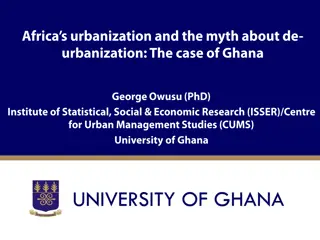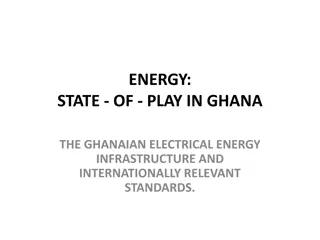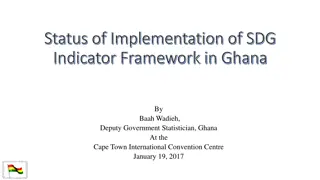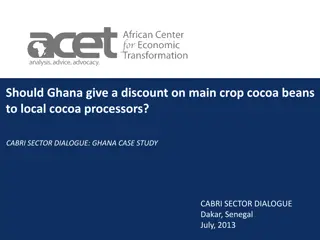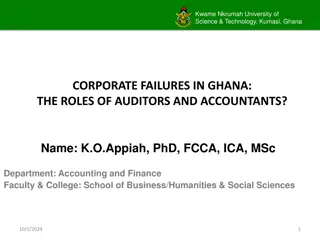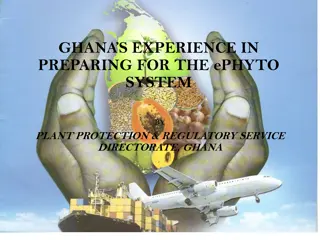Key Aspects of VAT Reforms in Ghana
Introducing VAT reforms in Ghana since 1998, the workshop discusses the challenges faced, the evolution of the tax regime, and the importance of comprehensive tax reforms. It delves into the original sales tax regime, ideal consumption tax models, and best practices for VAT implementation, emphasizing the significance of multi-stage collections, input tax credits, and transaction-based invoicing.
Download Presentation

Please find below an Image/Link to download the presentation.
The content on the website is provided AS IS for your information and personal use only. It may not be sold, licensed, or shared on other websites without obtaining consent from the author.If you encounter any issues during the download, it is possible that the publisher has removed the file from their server.
You are allowed to download the files provided on this website for personal or commercial use, subject to the condition that they are used lawfully. All files are the property of their respective owners.
The content on the website is provided AS IS for your information and personal use only. It may not be sold, licensed, or shared on other websites without obtaining consent from the author.
E N D
Presentation Transcript
VAT REFORMS IN VAT REFORMS IN GHANA THE WAY FORWARD THE WAY FORWARD ICA-G WORKSHOP GHANA: : SETH TERKPER, October 4, 2017
Introduction VAT [re]introduced in Ghana in 1998 Attempt in 1995 failed; planned since mid-1980s Replaced [selected] existing sales & service tax regime[s] Sales tax on imports and manufacturing VAT: tax on all transactions to distribution stage Collection in multiple [VA] stages, not single VAT Service [1998 to 2013]: Integration [IRS/VATS to DTD] VAT reforms? Not an isolated event Must be part of comprehensive tax reforms 10/4/2017 VAT reforms [ICAG Workshop] 2
Original Sales Tax regime Original Sales Tax regime (goods) Value ex Tax Taxable value Output Tax/VAT Input Tax/vAT Net/Gross Tax/VAT Price [tax plus] Comments Importer 1000 1000 175 175 1175 M facturer 800 1975 346 346 2321 Wholesaler 600 2921 2921 Not covered Retailer 400 3321 3321 Not covered Consumer 2800 3321 521 Rate [standard]17.50% Note: different service tax rates/regimes 10/4/2017 VAT reforms [ICAG Workshop] 3
What is the ideal consumption tax [under any method of collection]? What is a fair and efficient consumption tax? Ideal Tax Value Taxpayers ex Tax Stages Final Importer 1000 175 na Manufacturer 800 140 na Wholesaler 600 105 na Retailer 400 70 na Consumer 2800 490 490 Rate [standard] 17.50% 10/4/2017 VAT reforms [ICAG Workshop] 4
Cascading is not an option Full cascading to retail stage Value ex Tax Taxable value Output Tax/VAT Input Tax/vAT Net/Gros s Tax/VAT Price [tax plus] Comments All registered taxpayers Importer M facturer Wholesaler Retailer Consumer 1000 800 600 400 2800 1000 1975 2921 3832 4502 175 346 511 671 175 346 511 671 1702 1175 2321 pay sales tax without 3432 recourse to ITC 4502 4502 Rate [standard] 17.50% 10/4/2017 VAT reforms [ICAG Workshop] 5
Features of VAT regimes What is [generally-accepted] best practice ? Collection in multiple stages on value added Broad-based inclusive approach Prerequisite: making taxable supplies Transaction-based invoice-credit method Compare Addition and Subtraction methods Input Tax Credit [ITC] allowed to avoid cascading Pre-requisite: evidence of sales and purchases invoices Standard [single rate], with zero-rating for exports Invoices: Business-to-Business [B2B] & Business-to Consumer [B2C] 10/4/2017 VAT reforms [ICAG Workshop] 6
VATregistration at every stage Why ITC? Consumption, not business, tax Value Added Tax [All Registered] Value ex Tax Importer M facturer Wholesaler Retailer Value Added 1000 1800 2400 2800 Output Tax/VAT Input Tax/vAT Net/Gros s Tax/VAT Price [tax plus] Comments 1000 800 600 400 175 315 420 490 175 140 105 70 1175 B2B [ITC] 2115 B2B 2820 B2B 3290 B2B B2C [terminates; no ITC] 175 315 420 Consumer 2800 490 3290 Rate [standard] 17.50% 10/4/2017 VAT reforms [ICAG Workshop] 7
Invoice-credit method Main advantages Audit trail of [sales/purchase] invoices &records Self-accounting needs a purchase [input tax] invoice to claim VAT credit on a sales [output tax] invoice VAT registration threshold: main barrier to keeping invoice/records Voluntary registration is key to all Tax Administrations encouraging [not discouraging] recordkeeping 10/4/2017 VAT reforms [ICAG Workshop] 8
Features of VAT regimes Exceptions to best practice Registration threshold Level of turnover or sales below which no registration required Neutral simply turnover; not category of taxpayer, sector or commodity Sufficiently high to eliminate taxpayers who cannot keep adequate records [and of real nuisance value? real nuisance value?] Exemptions a limited schedule of taxable supplies Social intervention tool [education & health supplies ] Technical reasons [financial services; owner-occupied housing} Zero-rating application of zero-rate to exports So we do not export our taxes and be competitive 10/4/2017 VAT reforms [ICAG Workshop] 9
VAT Threshold Taking of the small taxpayer Value Added Tax [Exempt retailer] Net/Gro ss Tax/VAT Value ex Tax 1000 Taxable Value 1000 1800 2400 Output Tax/VAT Input Tax/vAT Price [tax plus] 175 140 105 Comments Importer Manufacturer Wholesaler 175 315 420 1175 B2B 2115 B2B 2820 B2B 800 600 175 315 Retailer [non- regustered] Consumer B2B [Input tax is cost] 400 2800 3220 na 420 na 3640 3640 B2C 420 Rate [exempt] Rate [standard] 17.50% Nil 10/4/2017 VAT reforms [ICAG Workshop] 10
VAT refunds: Zero-rating exports Value Added Tax [Exporter] Value ex Tax 1000 Value Added 1000 Output Tax/VAT Input Tax/vAT Net/Gross Tax/VAT Price [tax plus] Comments Importer 175 175 1175 B2B M facturer Wholesaler Exporter Consumer [foreign] 800 600 400 1800 2400 2800 315 420 175 315 420 140 105 (420) 2115 B2B 2820 B2B 2800 B2B 0 2800 0 2800 B2B [Foreigner] Rate [standard] Rate [export] 17.50% 0% 10/4/2017 VAT reforms [ICAG Workshop] 11
Basic VAT supply rules Supplies Refers to goods and services Only taxable supplies attract VAT (caters for exempt supplies) Place of supply Where the supply is made [key to exports] Time of supply At the time of issuing invoice or removal of goods (earliest) Value of supply Open market, at arms-length Taxpayer Anybody making taxable supplies 10/4/2017 VAT reforms [ICAG Workshop] 12
Summary and comparison Price Price Tax/VAT Tax/VAT Method Value Price Tax/VAT [Ideal] [Deviation] [Ideal] [Deviation] Original Sales Tax 2800 3321 3080 241 521 280 241 VAT: Ideal 2800 3290 3080 210 490 280 210 VAT: Exports 2800 2800 3080 (280) 0 280 (280) VAT: Threshold 2800 3640 3080 560 420 280 140 VAT: Full cascading 2800 4502 3080 1422 1702 280 1422 10/4/2017 VAT reforms [ICAG Workshop] 13
VAT Flat Rate Scheme [VFRS] and other Amendments VAT flat rate scheme introduced VAT flat rate scheme introduced GRA Public Notice [24 April 2017] provides the necessary guidelines the VAT (Amendment) Act 2017 (VATAA). VATAA provides for the introduction of the VAT flat rate scheme (the scheme) with respect to VAT and the National Health Insurance Levy (NHIL) 10/4/2017 VAT reforms [ICAG Workshop] 14
VAT Flat Rate Scheme [VFRS] and other Amendments Rates Rates Retailers and wholesalers of goods to replace the Standard rate 17.5% (VAT 15% plus NHIL 2.5%) with flat rate of 3% Standard rate of 17.5% remains applicable to imports VFRS not applicable to supply of any form of power, heat, refrigeration or ventilation under S27 of VAT Act 2013 Input tax Input tax Taxable persons making taxable supplies under VFRS are ineligible ITC. 10/4/2017 VAT reforms [ICAG Workshop] 15
VAT Flat Rate Scheme [VFRS] and other Amendments Exemptions [VAT/NHIL] Exemptions [VAT/NHIL] Domestic air transport Immovable property, including land to be used for, or intended to be used for, a dwelling Financial services Crude oil and residual fuel oil These amendments became effective from 7 April 2017 (i.e., the date of Gazette notification). 10/4/2017 VAT reforms [ICAG Workshop] 16
VFRS Impact of exempting wholesale/retail Value Added Tax [VFRS wholesale/retail] Value ex Tax Taxable Value Output Tax/VAT Input Tax/vAT Net/Gross Tax/VAT Price [tax plus] Comments Importer 1000 1000 175 175 1175 B2B [Standard 17.5%] Manufacturer 800 1800 315 175 140 2115 B2B [Standard 17.5%] Wholesaler [VFRS] 600 2715 81 na 81 2796 B2B [VFRS 3%; no ITC] Retailer [VFRS] 400 3196 96 na 96 3292 B2B [VFRS 3%; no ITC] Consumer 2800 492 3292 B2C Rate [standard] 17.50% Note: apportionment/allocation of input VAT Rate [VFRS] 3.00% 10/4/2017 VAT reforms [ICAG Workshop] 17
VFRS Registered Service Provider VAT [VFRS + registered Service Provider] Value ex Tax Taxable value Output Tax/VAT Input Tax/vAT Net/Gross Tax/VAT Price [tax plus] Comments Importer 1000 1000 175 175 1175 B2B [Standard 17.5%] Manufacturer 800 1800 315 175 140 2115 B2B [Standard 17.5%] Wholesaler [VFRS] 600 2715 81 na 81 2796 B2B [VFRS 3%; no ITC] Service provider Consumer 400 2800 3196 559 na 559 956 3756 B2B [Standard 17.5%] 3756 Note: apportionment/allocation of input VAT Rate [standard] 17.50% Can Service Provider claim ITC for 3% on an invoice? Rate [VFRS] 3% 10/4/2017 VAT reforms [ICAG Workshop] 18
VFRS Registered Exporter VAT [VFRS + Exporter]] Value ex Tax Taxable value Output Tax/VAT Input Tax/vAT Net/Gross Tax/VAT Price [tax plus] Comments Importer 1000 1000 175 175 1175 B2B [Standard 17.5%] Manufacturer 800 1800 315 175 140 2115 B2B [Standard 17.5%] Wholesaler [VFRS] 600 2715 81 na 81 2796 B2B [VFRS 3%; no ITC] Exporter 400 3196 0 na 0 3196 B2B [Exports 0%] Consumer 2800 396 3196 Rate [standard] 17.50% Note: apportionment/allocation of input VAT Rate [VFRS] 3% Can Service Provider claim ITC for 3% on an invoice? Exports 0% 10/4/2017 VAT reforms [ICAG Workshop] 19
VAT in Ghana Some issues to ponder about Breaking the value added chain Exemption for wholesalers and large retailers Not consistent with GRA segmentation & integration 3 rates applicable to small entities? Original threshold in VAT Act [Ghc200,000] not amended Income Tax Act [presumptive tax] 6% partly in lieu of VAT Flat rate [3 percent] could mean 9 percent for some small taxpayers 10/4/2017 VAT reforms [ICAG Workshop] 20
VAT in Ghana Some issues to ponder about To keep or not to keep recordsF Presumption that flat rate means minimal or no records Then flat rate not consistent with ITA Denial of ITC & exporting means cascading & inefficient regime Inability to secure invoices from flat rate beneficiaries Some benefiaries are large and in LTO already? Administration & compliance costs: records, systems, evasion & avoidance Exports may not be competitive 10/4/2017 VAT reforms [ICAG Workshop] 21
Way forward for VAT reforms? Think enhancements Put VERY BASIC VAT issues settled 20 years ago [1988 to 2018] to rest: will allow time to think about enhancements Tax policy: primacy of VAT as the ultimate consumption tax [compare basic objectives for income tax, excise, and tariffs] Organizational issues: Segmentation [client-focus]: VAT must be consistent with GRA s goal for Large, Medium, and Small taxpayer/offices Integration: make recordkeeping in particular easy for income tax and VAT taxpayers, based on segmentation 10/4/2017 VAT reforms [ICAG Workshop] 22
Way forward for VAT reforms? Think enhancements Electronic invoicing going paperless , including invoice matching e-commerce taxation of the internet [now apps ] Significant transactions being done via the internet Internet merging sectors of the economy are telcos also banks and vice versa? Cross-border issues physical as well as electronic [ECOWAS and various trade agreements] Where is the place of supply Who are suppliers and registered taxpayers? 10/4/2017 VAT reforms [ICAG Workshop] 23
Conclusion Focus on enhancements, not brood over basic principles that do not reflect best practice Time to settle for the KISS [keep it simple, stupid] rule Ghana is not an island , lets take a cue Why is there no rush to introduce flat rate schemes? Hopefully, on the 20th anniversary of VAT in 2018 we will meet to discuss ICAG s standards on VAT 10/4/2017 VAT reforms [ICAG Workshop] 24
THANK YOU 10/4/2017 VAT reforms [ICAG Workshop] 25
